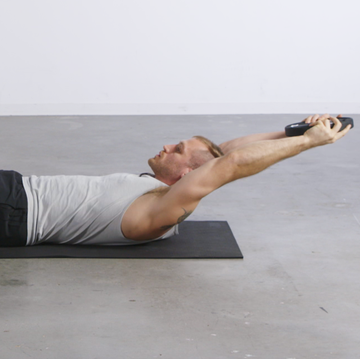If you’re like most guys, you’re a creature of habit: You go to bed at 11 p.m., hit the john after your morning joe, and run the same loop at the same speed.
That’s great for sleeping and pooping, but not so good for your fitness or race times. Research from Canada and New Zealand reveals that different kinds of running deliver specific fitness benefits.
Shorter intervals, for instance, increase your VO2 max (one measure of aerobic endurance), while longer sessions boost your “Qmax,” the volume of blood your heart can pump.
Smart (and fast) guys take advantage of four key types of training—speedwork, threshold sessions, speed-stamina workouts, and relaxed long runs—to race better and boost fitness. Even marathoners can benefit from lung-busting 100-yard dashes.
In fact, Tom Kloos, coach of the elite Bay Area Track Club, says that failing to mix up training is the biggest mistake he sees runners make.
“The best improvement I’ve seen is with speed-work,” says Kloos, who’s also the track and cross-country coach at Saint Mary’s College in Moraga, California. “It improves the way you move, your biomechanics, and your running economy. That way you can run at race pace much more comfortably.”
We’ll show you the science-based benefits of each kind of workout and how to best fit it into your training.
Speedwork
What is it?
A 30-minute sprint workout. This training improves your stride, recruits more fast-twitch muscles, and builds your fitness quickly.
The Details
Warm up with a 1-mile jog followed by form drills: 15 seconds each of skips, butt kicks, knee raises, and fast feet (hit the ground as rapidly as you can). Do 3 sets. To prime your muscles for sprinting, do dynamic activation: 30 seconds of mountain climbers followed by climbing 20 steps (or 20 stepups on a bench). Repeat.
Now you’re ready for the speedwork: Do 30-, 40-, 50-, and 60-yard all-out sprints from a standing start. Walk back for recovery. Then do 120 yards fast three times, but not quite at a full sprint. Jog back. To cool down, run a half mile, progressing from a steady to a very easy pace.
Sprinting uses more fast-twitch muscle fibers than distance running does, and it teaches you good form—that is, pumping your arms, keeping your head and chest up, and driving your knees forward. (Find out more about How to Perfect Your Running Form.)
If you understand how this motion propels you, then you’ll also recognize when you’re breaking form during a longer run—and know how to correct it. “You learn to run faster with less effort. That’s a win-win,” says Kloos.
The downside? Sprints are hard on your joints. You’re pounding them with up to 700 percent of your body weight with every footstrike. At slower speeds, half your motion is powered by muscle contraction and half by the energy stored in your tendons, says Jay Dicharry, M.P.T., S.C.S., director of the Rep Lab in Bend, Oregon.
Your feet spend about a quarter of a second on the ground when you run slowly, and just an eighth of a second when you sprint.
“You don’t have time for the stored elastic energy to help you out when you’re sprinting, so almost all the work comes from active muscle contraction,” he says.
That’s why Kloos advises giving yourself 48 to 72 hours to recover from this training.
(The Secret to Running Faster may just be in how you breathe.)
Threshold Session
What is it?
Running for 30 to 60 minutes at your threshold pace—the speed you can maintain without breathing so hard that you need to slow down.
It improves your aerobic capacity and helps you incinerate more calories than other kinds of running, because you’re working at a higher intensity for a long period with no rest.
Related: Can Aerobic Exercise Make You Smarter?
The Details
Run at your threshold pace for 4 to 6 miles. When this workout becomes easier, run up to 30 minutes more when training for a 10K or less, and up to an hour more for longer races. Then work on increasing your pace.
There are various ways to figure out your threshold pace, says Kloos. You can go by feel: It should seem hard but still be manageable to maintain. (That’s why it’s crucial not to push the pace fresh out of the gate.)
You can also use a running table: If you’ve done a 5K or 10K, enter your time in the McMillan Running training calculator.
A rule of thumb, he says, is to go slightly slower than your 10K race pace, or add 40 seconds to your per-mile 5K pace.
If you tend to lose focus partway through a session, run with a friend. It’s more fun, and you can keep each other on pace. If you can talk to your friend but don’t really want to, your pace is about right, Kloos says. “Your breathing has to be at that level.”
Speed-Stamina Workout
What is it?
High-speed repetitions of 200 to 1,600 yards. This is the most physically demanding and mentally challenging kind of running, says Kloos.
The payoff for your 45 minutes of suffering is a stronger heart and more stamina. Longer intervals increase your heart “contractility” (the force of each beat) as well as the density of the mitochondria (cellular power plants) in your legs.
The Details
Warm up by jogging at an easy pace for a mile. Then do these form drills: 15 seconds each of skips, butt kicks, knee raises, and fast feet.
Do 3 sets, and then prep your muscles for sprinting. Do four 80-yard acceleration striders (increase your speed incrementally until you’re going fast but are still relaxed and not in a full sprint; walk back).
The intervals: Do 8 x 500 yards with a 100-yard walk recovery. The pace should be the fastest you can maintain for the entire workout. The recovery walk should take the same time as the 500-yard run.
To cool down, jog slowly for a mile or two.
Long intervals aren’t for the faint of heart, but they’re great for your ticker. A recent Finnish study found that this kind of high-intensity interval training increased VO2 max, heart rate variability (a good indicator of cardiac health), and muscle capillary density, all of which help move oxygen throughout your body so you can exercise harder for longer.
You also burn major calories through excess postexercise oxygen consumption (EPOC). In other words, you work out so hard that you keep burning calories even after the clock stops.
Related: The Most Effective Cardio Workout for Your Body
But don’t overdo it. “Four to six of these speed-stamina workouts is all it takes before you’re maxing out the benefits,” says Kloos. He suggests adding them to your training regimen eight weeks before a race. Do one every other week or so, completing four to six sessions total.
Relaxed Long Run
What is it?
A slow and steady run. These burn the most fat and increase your stamina. But they can be hard on your joints if you have poor form or weak legs, so work up to longer distances.
The Details
Run for an hour or longer at a pace that allows you to easily hold a conversation. If you get too winded, walk until you’re breathing easily. Then resume running.
Running at a lower intensity for long distances is still the gold standard for endurance training.
In fact, many elite athletes divide their training into 70 percent relaxed long runs, 10 percent threshold sessions, and 20 percent sprints, says Alex Hutchinson, Ph.D., Runner’s World’s Sweat Science columnist.
“This balances out the hard sessions that yield the swiftest gains with the easier ones that allow for recovery and continued improvement.”
If you’re looking to become lean, emphasize long runs. At 60 minutes, your body starts to draw from fuels other than just your blood sugar; this process can help you lose fat faster, says Kloos.
(Check out these 5 Ways to Avoid Burning Out on Long Runs.)
What’s Your Goal?
How often should you be completing each of these workouts? Pick your goal below for a custom training plan from Coach Kloos.
I want to be in better shape.
Use a two-week cycle and aim to do one of each workout every two weeks.
On other days, do strength training. If you can run three times a week, add two relaxed long runs.
I want to be more competitive in a 10k road race, tough mudder, or marathon.
Use a two-week cycle, being sure to do all four workouts every two weeks.
If you can run six times per cycle, base the extra runs on the time to race day: Six months out, add a relaxed long run, and alternate between threshold sessions and speed-stamina workouts for your other extra workout.
Three months: Add a threshold session, and alternate relaxed long runs and speed-stamina workouts.
Two months: Add speedwork; alternate threshold and relaxed runs.
Related: How Many Long Runs Should I Do Before a Marathon?
I want to drop pounds.
Both plans work equally well for losing weight.












